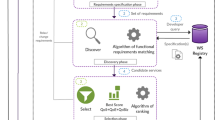Abstract
Semantic refinement of stakeholders’ requirements is a fundamental issue in requirements engineering. Facing with the on-demand collaboration problem among the heterogeneous, autonomous, and dynamic service resources in the Web, service requirements refinement becomes extremely important, and the key issue in service requirements refinement is semantic interoperability aggregation. A method for creating connecting ontologies driven by requirement sign ontology is proposed. Based on connecting ontologies, a method for semantic interoperability aggregation in requirements refinement is proposed. In addition, we discover that the necessary condition for semantic interoperability is semantic similarity, and the sufficient condition is the coverability of the agreed mediation ontology. Based on this viewpoint, a metric framework for calculating semantic interoperability capability is proposed. This methodology can provide a semantic representation mechanism for refining users’ requirements; meanwhile, since users’ requirements in the Web usually originate from different domains, it can also provide semantic interoperability guidance for networked service discovery, and is an effective approach for the realization of on-demand service integration. The methodology will be beneficial in service-oriented software engineering and cloud computing.
Similar content being viewed by others
References
He K, Peng R, Liu W et al. Networked Software. Science Press, China, 2008. (in Chinese)
Karim S, Latif K, Tjoa A M. Providing universal accessibility using connecting ontologies: A holistic approach. In Proc. the 4th Int. Conf. Universal Access in Human Computer Interaction, Beijing, China, Jul. 22–27, 2007, pp.637–646.
Cregan A. W3C semantic Web ontology languages: OWL and RDF tutorial. In ISO/IEC JTC1 SC32 11th Open Forum on Metadata Registries, Tutorial, Sydney, Australia, May 19–22, 2008.
He K, He Y, Wang C et al. Ontology and Metamodeling Theory, Method and Applications. Science Press, China, 2008. (in Chinese)
Wang J, He K, Gong P et al. RGPS: A unified requirements meta-modeling frame for networked software. In Proc. the 3rd International Workshop on Advances and Applications of Problem Frames (IWAAPF 2008) at 30th International Conference on Software Engineering (ICSE 2008), Leipzig, Germany, May 10–18, 2008, pp.29–35.
Stabb S, Studer R (eds.). Handbook on Ontologies. International Handbooks on Information Systems, Springer, 2004.
Heflin J, Hendler J. Semantic interoperability on the Web. In Proc. Extreme Markup Languages 2000, Alexandria, USA, Aug. 15–18, 2000, pp.111–120.
SIM-TBASSC. http://www.isi.edu/tbassco/index.html, Oct. 15, 2008.
Pierre L, Jean M R et al. A Deployment and Research Roadmap for Semantic Interoperability: The EU SemanticHEALTH Project. eHealth Beyond the Horizon — Get IT There, Andersen S K et al. (eds.), 2008, pp.635–640.
Cleverdon C. The Cranfield Tests on Index Language Devices. Morgan Kaufmann Multimedia Information and Systems Series, Morgan Kaufmann Publishers Inc., 1997, pp.47–59.
Ehrig M, Euzenat J. Generalizing precision and recall for evaluating ontology matching. In Proc. the 4th International Semantic Web Conference (ISWC), Poster Session, Galway, Ireland, Nov. 6–10, 2005, PID-54.
Euzenat J. Semantic precision and recall for ontology alignment evaluation. In Proc. the 20th International Joint Conference on Artificial Intelligence (IJCAI), Hyderabad, India, Jan. 6–12, 2007, pp.348–353.
Budanitsky A. Lexical semantic relatedness and its application in natural language processing. Technical Report CSRG390, University of Toronto, 1999.
Budanitsky A, Hirst G. Semantic distance in Word-Net: An experimental, application-oriented evaluation of five measures. In Proc. the NAACL 2001 Workshop on WordNet and Other Lexical Resource, Pittsburgh, USA, Jun. 3–4, 2001, pp.29–34.
Liang P, Jansen A, Avgeriou P. Sharing architecture knowledge through models: Quality and cost. The Knowledge Engineering Review, 2008, 23(4): 225–244.
Ganesan P, Garcia-Molina H, Widom J. Exploiting hierarchical domain structure to compute similarity. ACM Transactions on Information Systems, 2003, 21(1): 64–93.
Seidenberg J, Rector A. Web ontology segmentation: Analysis, classification and use. In Proc. the 15th International Conference on World Wide Web, Southampton, UK, May 11–14, 2006, pp.13–22.
Zeng C, He K, Yu Z eta al. Towards improving Web service registry & repository model through ontology-based semantic interoperability. In Proc. the 9th International Conference on Grid and Cooperative Computing, Shenzhen, China, Oct. 24–26, 2008, pp.747–752.
Chen H, He K, He Y et al. An automated approach for requirements driven model selection. In Proc. the 1st International Workshop on Data and Semantic Engineering for Emerging Technology and Services, Busan, Korea, Nov. 11–13, 2008, pp.1052–1057.
Ivan M et al. (eds.). Collaborative Software Engineering. Springer, 2009.
Author information
Authors and Affiliations
Corresponding author
Additional information
This work is supported by the National Basic Research 973 Program of China under Grant No. 2007CB310801, the National Natural Science Foundation of China under Grant Nos. 60970017 and 60903034.
Rights and permissions
About this article
Cite this article
He, KQ., Wang, J. & Liang, P. Semantic Interoperability Aggregation in Service Requirements Refinement. J. Comput. Sci. Technol. 25, 1103–1117 (2010). https://doi.org/10.1007/s11390-010-9392-3
Received:
Revised:
Published:
Issue Date:
DOI: https://doi.org/10.1007/s11390-010-9392-3




